
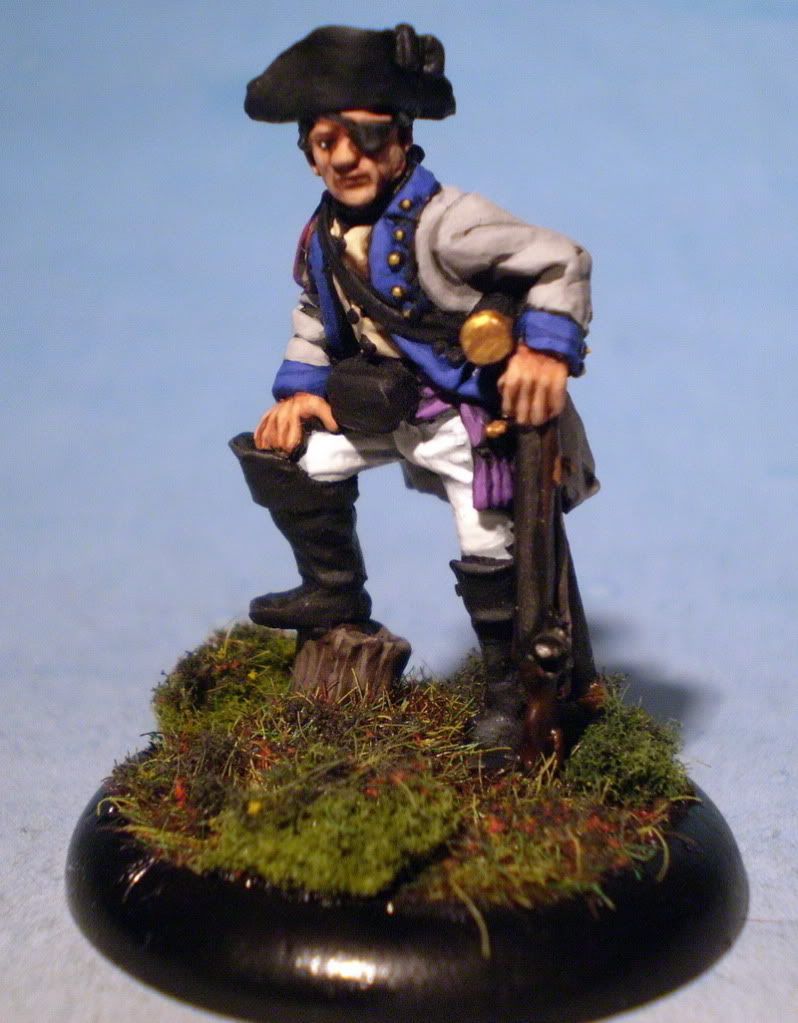
 Got to play this relatively new set of French & Indian War rules yesterday over at my buddy Thomas house. I have to say that this is a solid set of rule that appear to have fixed some of the gripes I had with This Very Ground - more about a comparison with the two sets later.
Got to play this relatively new set of French & Indian War rules yesterday over at my buddy Thomas house. I have to say that this is a solid set of rule that appear to have fixed some of the gripes I had with This Very Ground - more about a comparison with the two sets later.First of all, a brief rundown of the rules.
This is a D6 based skirmish game where each player controls relatively small units (4-12 miniatures) that together form a war party. Units range from regular European infantry drilled to fire in rank and file formation, irregulars that move swiftly through terrain, your cannon fodder low grade militia, some cavalry and some artillery is also thrown into the mix but does not play that big of a role due to historical restrictions and the skirmish nature of the game.
Players also field various officers that can be given either static abilities connected to their troop type background or randomly determined one's. Officers are limited in number but fulfill the important role of acting as morale boosters and due to their various skills and traits they can provide very interesting contributions to the battlefield. Officers are also given so called "sub plots" that become something of a secondary mission objective for your warband to achieve. These sub plots act both as tie breakers and grade the victory conditions on a slightly wider scale than just having "win / lose" conditions.
The unit activation sequence, turn initiative and number of actions a unit can perform is all controlled by a card mechanic which I got to say is both a fresh breeze and provides a fantastic flow of the action.
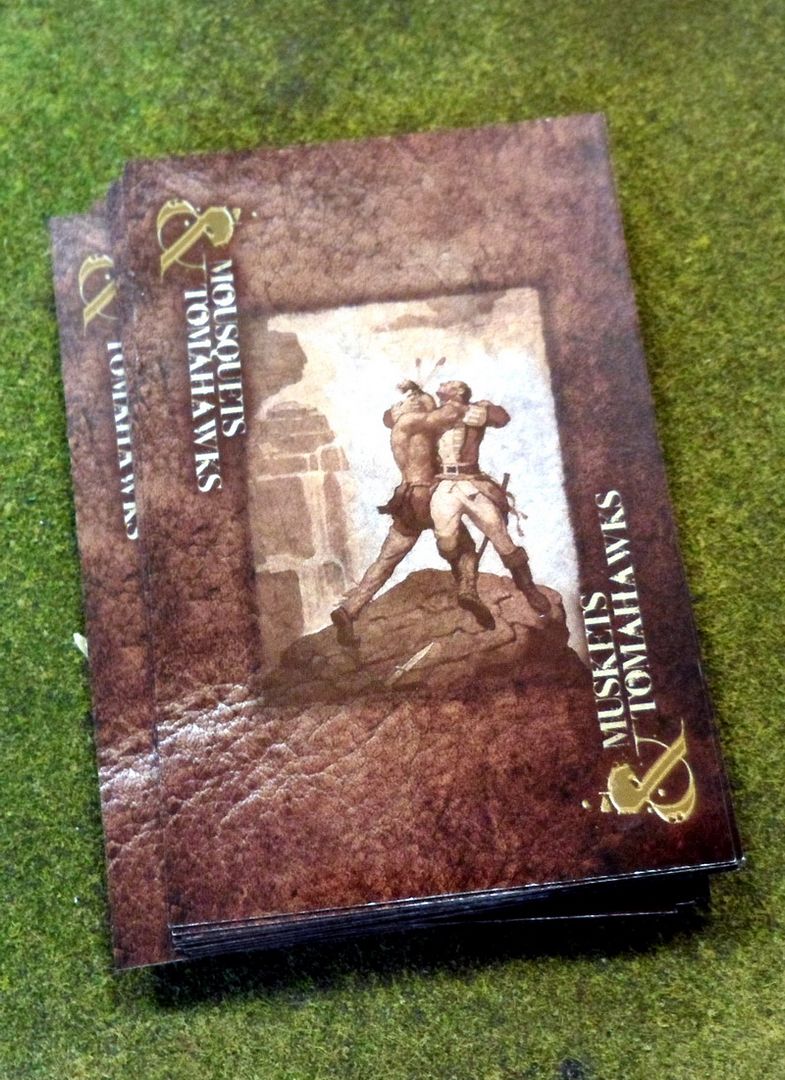
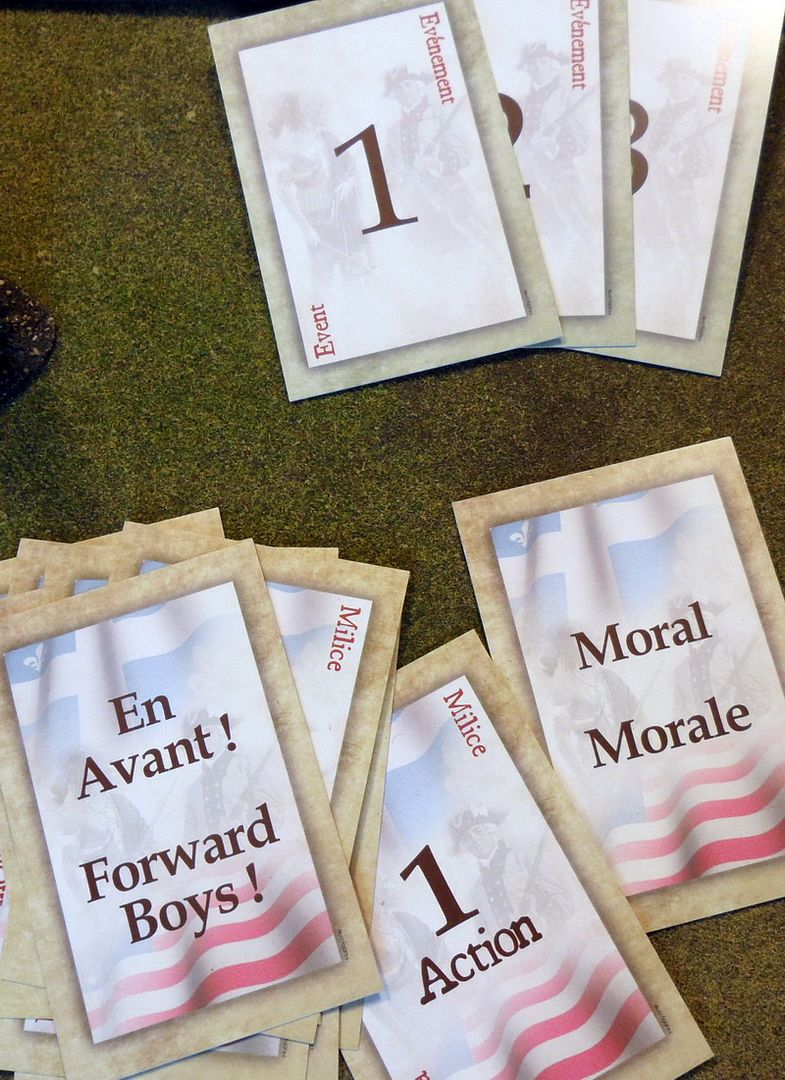
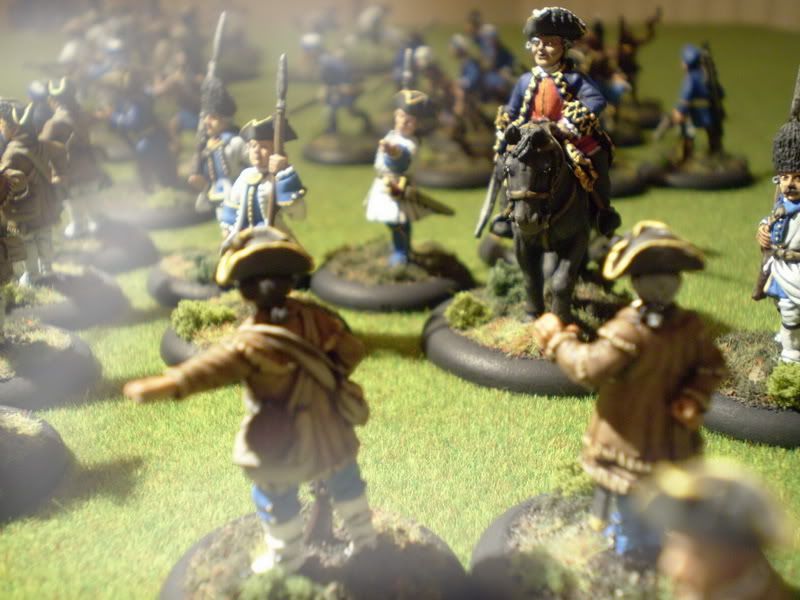
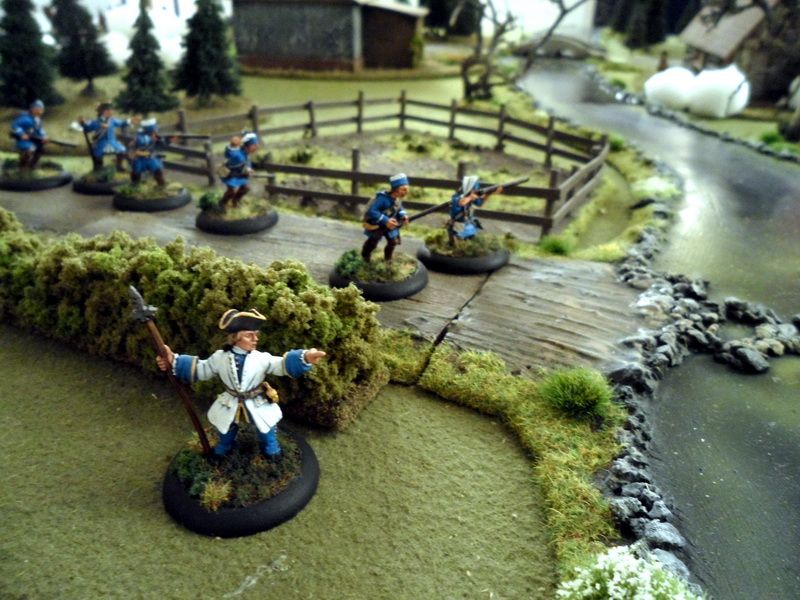 Now for a more detailed description of the major features:
Now for a more detailed description of the major features:This game is based around the D6, troops have a few basic stats such as shooting, attack and defense in close combat as well as morale. All of these are determined by rolling a D6, and more often than not, you apply some kind of modifier - be if for range/cover when shooting or for having taken a high amount of casualties or being fired upon at point blank range.
The game does allow for results beyond 6, the so called "7+". Interestingly no matter how bad it is you always "hit" on 6's when firing your weapons BUT the impact from the bullet gets weaker the and less lethal with distance/against heavy cover. The way the game handles these 7+ results is simply by making the "to kill" roll receive -1 negative modifier for each step beyond a natural 6. I personally think that the game would probably have been more at home using D10's but the way things are written has a good flow and work well enough not to bother me.
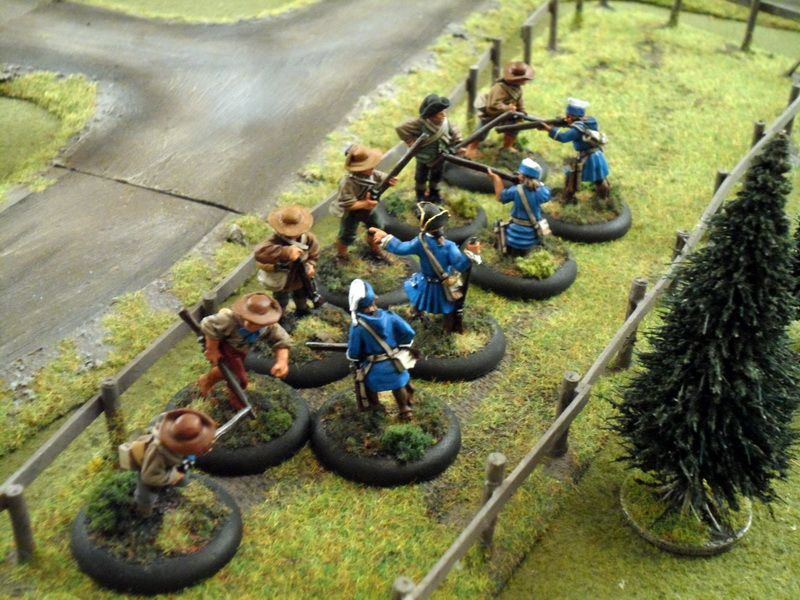 Muskets & Tomahawk's also features a "spotting" mechanic, which limits how far miniatures can see enemy models. This distance is affected by range, terrain, weather conditions (fog/mist/snow/rain) and time of day. There is a sliding scale that either makes it easier or harder to see the enemy, an example can be enemy troops moving through the night inside woods - until they fire their weapons the enemy must be very close to see (and be able to
Muskets & Tomahawk's also features a "spotting" mechanic, which limits how far miniatures can see enemy models. This distance is affected by range, terrain, weather conditions (fog/mist/snow/rain) and time of day. There is a sliding scale that either makes it easier or harder to see the enemy, an example can be enemy troops moving through the night inside woods - until they fire their weapons the enemy must be very close to see (and be able to 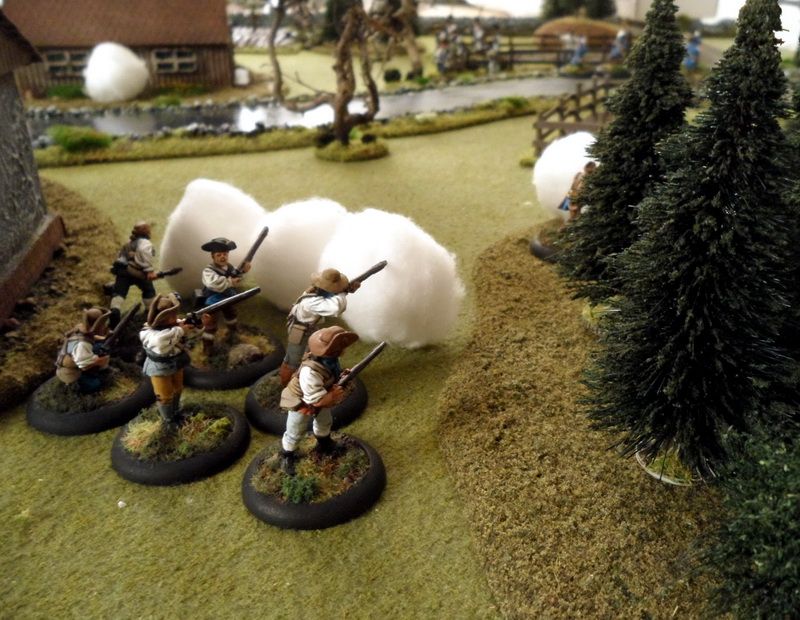 shoot) them. However once this sneaky unit opens fire, the flashes and smoke from their muskets reveal their positions and reduces the spotting distance by two steps. The mechanic works well and is easy to apply. The game also features "hidden movement" where units blend into the terrain and are then symbolized by a marker moving around until revealed by the enemy.
shoot) them. However once this sneaky unit opens fire, the flashes and smoke from their muskets reveal their positions and reduces the spotting distance by two steps. The mechanic works well and is easy to apply. The game also features "hidden movement" where units blend into the terrain and are then symbolized by a marker moving around until revealed by the enemy.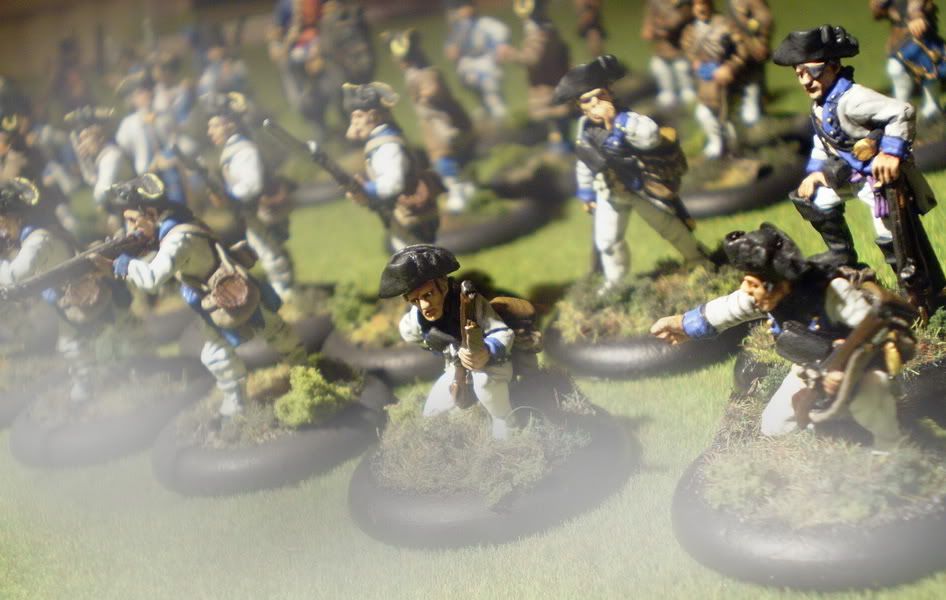 Activating units is probably the most interesting aspect of this game, and something I was worried about but which turned out to be really good. Basically both players have units that belong to certain troop types, such as Irregular, Militia, Indians, Regular and so on. Each
Activating units is probably the most interesting aspect of this game, and something I was worried about but which turned out to be really good. Basically both players have units that belong to certain troop types, such as Irregular, Militia, Indians, Regular and so on. Each  troop type, regardless of how many units you have, comes with a certain amount of unit activation cards. Both players combine a shared deck of cards marked with the nationality and troop type symbols and simply draw and resolve one card at a time. When a card is drawn the nation owning the card activates ALL of the units belonging to that type printed on the card. There are a couple of twists here, basically all unit types have 4 actions that can be performed each game turn. But the amount of cards vary from unit type to unit type. Regulars have their 4 actions split between two cards that both allow activation and performing of 2 actions. Indians on the other hand have their 4 actions spread out across 4 cards, meaning they will activate twice as many times as the Regulars - but may only perform a single action each time.
troop type, regardless of how many units you have, comes with a certain amount of unit activation cards. Both players combine a shared deck of cards marked with the nationality and troop type symbols and simply draw and resolve one card at a time. When a card is drawn the nation owning the card activates ALL of the units belonging to that type printed on the card. There are a couple of twists here, basically all unit types have 4 actions that can be performed each game turn. But the amount of cards vary from unit type to unit type. Regulars have their 4 actions split between two cards that both allow activation and performing of 2 actions. Indians on the other hand have their 4 actions spread out across 4 cards, meaning they will activate twice as many times as the Regulars - but may only perform a single action each time.
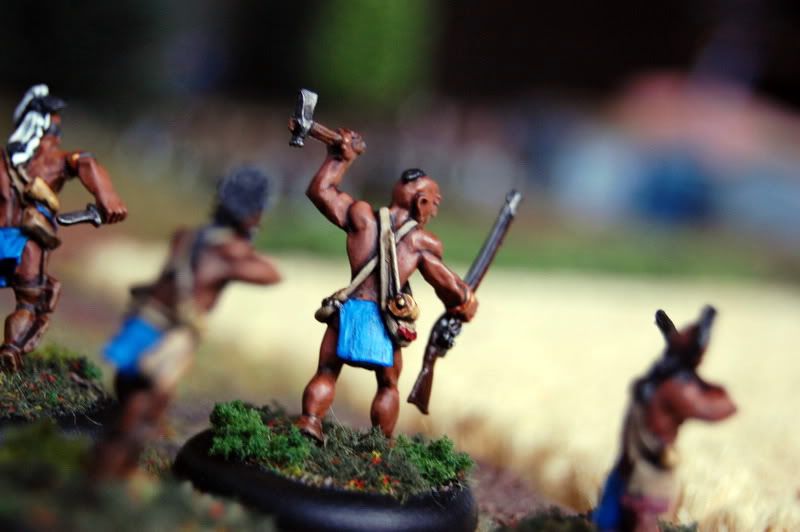 And since cards are drawn at random this provides a very dynamic gaming experience that is both unpredictable enough in terms of what units will activate in which order - but also makes units do stuff very
And since cards are drawn at random this provides a very dynamic gaming experience that is both unpredictable enough in terms of what units will activate in which order - but also makes units do stuff very 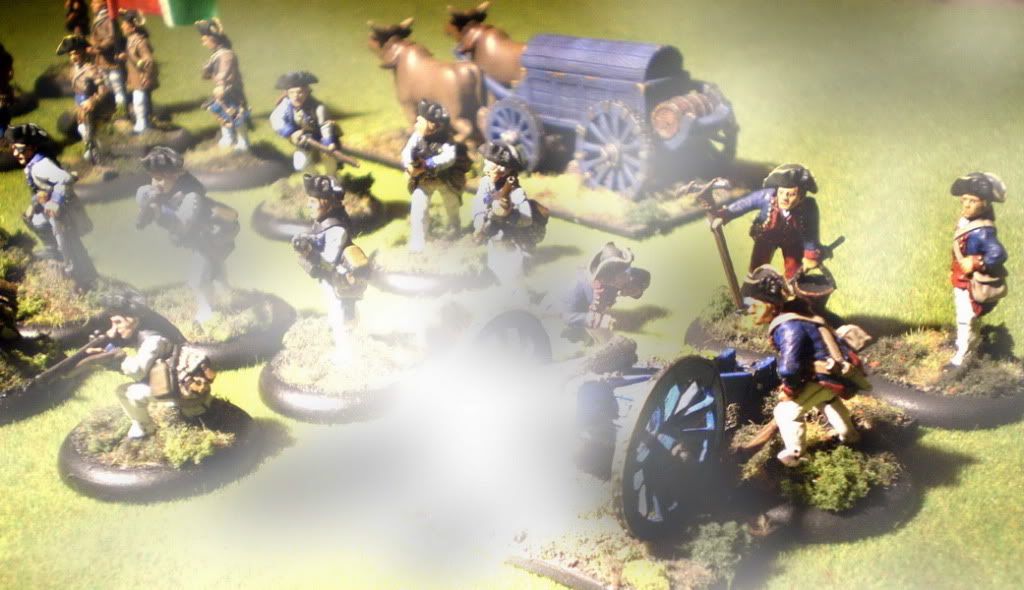 often in comparison to other games out there. Another thing that Muskets & Tomahawk's have done very clever is to have players activate units - but within those units models may perform different actions. This means that you can move into better position with a couple of miniatures while the rest are firing, have half the unit fire while half are reloading and so on. It allows for a lot of tactical choice without having them scripted as separate rules, such as different firing modes.
often in comparison to other games out there. Another thing that Muskets & Tomahawk's have done very clever is to have players activate units - but within those units models may perform different actions. This means that you can move into better position with a couple of miniatures while the rest are firing, have half the unit fire while half are reloading and so on. It allows for a lot of tactical choice without having them scripted as separate rules, such as different firing modes.And since each action only allows for one single thing to be done it does add the feeling of using muskets and rifles that are slow to reload.
 The way games are set up is that both players roll dice to see what kind of weather conditions will be in place, then each player - depending on what type of troops his force is made up of - rolls to see what his objective will be. The objectives (there are 6 basic objectives) can be to scout the table and report back home or slaughter enemy settlers. Some of these are limited to 1 per game, so you can't have two players "Defending". Players then "roll sub plots" for their officers and add these to their victory conditions, there are a lot of these and they are full of character and some of them are really funny if you hit the right combinations on both sides (in our game Thomas had a cowardly officer and my Officer was out to seek truce and was not allowed to begin hostilities haha).
The way games are set up is that both players roll dice to see what kind of weather conditions will be in place, then each player - depending on what type of troops his force is made up of - rolls to see what his objective will be. The objectives (there are 6 basic objectives) can be to scout the table and report back home or slaughter enemy settlers. Some of these are limited to 1 per game, so you can't have two players "Defending". Players then "roll sub plots" for their officers and add these to their victory conditions, there are a lot of these and they are full of character and some of them are really funny if you hit the right combinations on both sides (in our game Thomas had a cowardly officer and my Officer was out to seek truce and was not allowed to begin hostilities haha).Stuff like morale is also handled quite well, there is a small chart that is divided between troop types and morale levels. You roll a D6 and depending on how well you roll (with added positive/negative modifiers) your troops can either hold their ground, recoil (move back but keep facing the enemy), start fleeing or rout off the table. You roll for morale each time a model in a unit is killed, you don't roll for morale if you are fired upon, hit but not wounded.
There are also random event cards in the game, which once again plays out better than anticipated. They are numbered from 1 - 3, and you have to draw them in the correct order for them to come into effect. "Event 1" has to be the first event card drawn during a turn to have it come into effect. When it does you roll a D66 and check a table for the results. This adds some flavor without having events spam your game. In our game we only had one single effect come into play. I was afraid it would dominate the game a lot more. The effects range from changing weather to units starting to panic or go berserk, a long list of stuff that can happen.
Really all the charts with effects, traits, side plots and so on feel very well written and good. The army lists contain France, Britain, Americans (13 colonies), German mercenaries (Hesse-Kessel), Indian nations. There are also profiles for civilians and such that appear in certain scenarios. The army lists for the British and the French have a few tweaks that allow you to make them appear as French & Indian War or American War of Independence themed. The Americans and German mercenaries are intended for the AWI, while the Indians are generic in theme. The lists contain a wide variety of troop types and allow players to field pretty much all troop types in a single warband, meaning you can have a core of Regular troops backed by light infantry, militia and Indian allies if you want.
The way the game activates units with the card mechanic, I think it is more reasonable to field a mixed force than a "pure" one that uses only one troop type. Especially if your opponent has a mixed force. The more cards you have in the deck for your own troops the better the odds for your troops to act. For instance if you have but Regular troops in your force, then your contributions to the shared deck will be limited to 2 "Regular" activation cards. At the same time your opponent may have 4 militia, 4 Indian and 3 Provincial cards. This will (at least in smaller games) risk having you be shot to pieces before you can react.
Short comparison with This Very Ground
This Very Ground is another game meant for French & Indian War/American War of Independence skirmish on pretty much the exact same level as M&T. There are a few important differences that for me favor M&T these are mainly:
Shooting mechanics. TVG had several firing modes hat in detail determined the amount of muskets firing inside a unit and this determined how the amount of reload time a unit had to spend to keep firing at the same rate or at full rate. TVG featured such things as firing with a constant stream which never really required you stop firing to reload but which at the same time limited the efficiency of the firing to a bare minimum. M&T handles the shooting and reload in a much more fluid and less restricted manner. All models that fire must spend an action to reload (or two if you reload a Rifle), however you can yourself determine the volume of fire from a unit in M&T, there are no troop type restrictions as there was in TVG.
Movement mechanics: TVG was once again a game with a detailed description of movement rates and how various terrain types affected certain unit types. M&T is a bit more abstract, units have a specific movement rate and then a troop type that add "movement in terrain" modifiers. Scouts can move effortlessly in terrain that other troops would find difficult and so on. The game does however not include such things as being formed in a column to increase the movement rate as you could in TVG.
The common thing shared between both games is that Regular infantry formed in Line formation cannot enter terrain or even work in difficult terrain at all. At the same time M&T allows a much more fluid form/re-form ability of you regular troops. You decide yourself when the time is right to form your men rather than have them act in line formation throughout the game. This little detail of being able to spend one action to scramble together a line formation and using a second action to fire (and in the subsequent turn reload and disperse again) does a lot to provide the game with a greater flexibility.
Close combat in TVG was more detailed in that you had a lot of various weapons with their own modifiers and that game took into account the number of models charging and the number of models being the target unit - you also had to roll psychology tests to charge and your chances of being able to do so depended on how well prepared/armed the enemy unit was. In M&T the assaults are more abstract, this is the only phase where units roll "saves" and combat ends either when one side breaks off due to failed morale after having suffered more casualties than the opponent or both sides keep fighting until the enemy is wiped out.
Casualties/Morale: Both games have the player roll for morale when he loses troops, however one thing that is missing from M&T but which is present in TVG is how coming under fire from certain weapons affect the psychology of the target unit. In TVG coming under fire from muskets was unnerving enough, getting fired upon by a massed volley was terrifying. You often scattered troops by simply firing at their position. In M&T you have to kill at least 1 model to cause a morale roll.
And while TVG had different penalties to morale depending on the volume of fire that was shooting at you M&T provides one very important thing - and that is a negative morale modifier for being fired upon by an enemy that your troops can't see.
Both games feature basically the same army lists, M&T does use D6's while TVG uses D10. TVG has a lot of scenarios online which you can download while M&T has something that resembles a scenario generator written into the rules.
Final verdict:
Muskets & Tomahawk's is my new "go to" set of rules when I want to play French & Indian War games on a skirmish level using 20-50 miniatures per side organized into small units. The rules are not complicated but offer enough complexity to be interesting, thematic and charming. They are also easy to use for a pickup game and the different card based activation system is truly the greatest asset to this game. I think that whether or not you like this game will be determined by the card mechanic, it's just so smooth. Though I am sure it can create difficulties if both players decide to field completely different types of warbands to the point where the number of cards differ too greatly between the nations involved.
The only universal drawback of Musket & Tomahawk's is the extremely steep price of the rules. Considering that the book is 62 pages softcover black and white, granted that you get a deck of activation cards, the price of £24 is a bit much imo. A reasonable level would have been something like £18 and have the deck of activation cards as a downloadable PDF file. Still, what you actually get is in the end worth it.
No comments:
Post a Comment